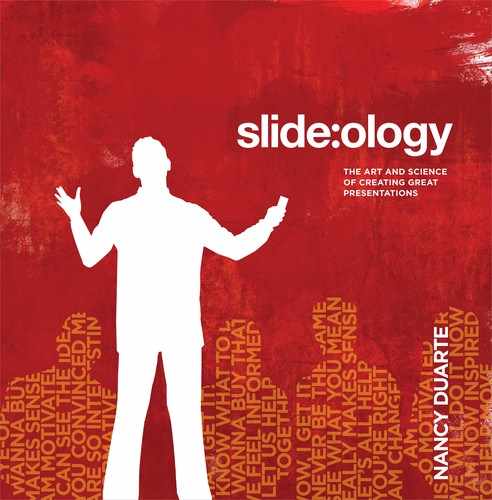6 slide:ology
Use the right tool the right way.
On the other hand, it’s natural for people to simultane-
ously pay attention to both verbal and visual communi-
cation. That’s why great slides serve as a visual aid that
reinforces the speaker’s message.
However, the heavy use of text occasionally might be
appropriate, but in such a case, you should be careful
what medium you use. Too often, presentation software
is used to create documents. Garr Reynolds, author of
Presentation Zen, calls these slideuments. So before your
next presentation, assess how you’ve used the applica-
tion. Did you create a document or a presentation? Either
adjust your documents into slides or trust that your audi-
ence is smart enough to read and circulate your slides as
a document.
So Where Do You Begin?
“Communication is about getting others to adopt your
point of view, to help them understand why you’re
excited (or sad, or optimistic, or whatever else you are).
If all you want to do is create a file of facts and figures,
then cancel the meeting and send in a report.”
Seth Godin,
Author, Really Bad PowerPoint
People will love you for respecting their time enough to
use the media appropriately.
At a certain point, the number of words on a slide pre-
vents it from being a visual aid. You’ve been there. The
audience is reading the slides instead of paying atten-
tion to the presenter, the presenter is reading the slides
instead of connecting with the audience, and the whole
endeavor would have been better served through a
well-composed document or even an email.
Unfortunately, the negative habits that lead to this kind
of presentation style are deeply rooted and difficult to
change. But consider this: audiences will either listen to
what a presenter is saying or read the slides themselves.
They won’t do both. Why? People tend to focus on one
stream of verbal communication at a time—listening and
reading are conflicting activities.

Creating a New Slide Ideology 7
The audience will either read your slides or listen to you. They will not do both. So,
ask yourself this: is it more important that they listen, or more effective if they read?
Document Teleprompter Presentation
Dense content in a presentation intended
as a discussion document or whitepaper;
a slideument.
If a slide contains more than 75
words, it has become a document.
You can either reduce the amount of
content on the slide and put it in the
notes, or admit that this is a docu-
ment and not a presentation. If it is
the latter, host a meeting instead
of a presentation, and circulate the
slideument ahead of time or allow
the audience to read it at the start.
Then you can use the remainder of
the meeting to discuss the content
and build action plans.
Text on the slide functions as a crutch for
the presenter. The audience either reads
the slides or listens to the presenter.
Presentations with 50 or so words
per slide serve as a teleprompter.
This less-than-engaging approach
often results from a lack of time
spent rehearsing the content, and is
the default style of many profession-
als. Unfortunately, presenters who
rely on the teleprompter approach
also usually turn their backs to the
audience. The audience may even
perceive such presenters as slow, as
the audience reads ahead and has to
wait for the presenter to catch up.
Slides are effectively used as a visual
aid to reinforce the presenter’s message.
True presentations focus on the pre-
senter and the visionary ideas and
concepts they want to communicate.
The slides reinforce the content visu-
ally rather than create distraction,
allowing the audience to comfortably
focus on both. It takes an investment
of time on the part of the presenter
to develop and rehearse this type of
content, but the results are worth it.
This book primarily
focuses on presen-
tations that are on
the far right of this
spectrum.

Mark Templeton
CEO, Citrix
..................Content has been hidden....................
You can't read the all page of ebook, please click here login for view all page.
